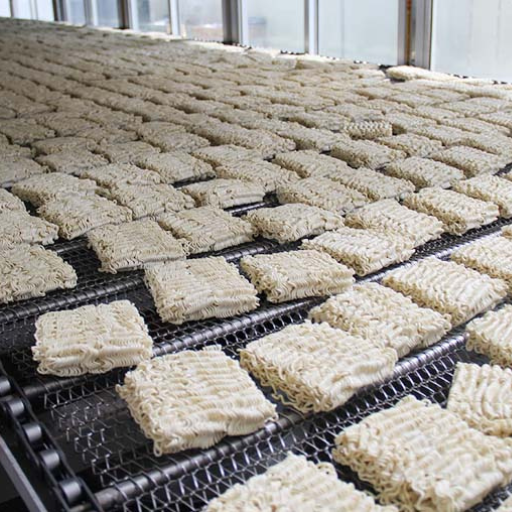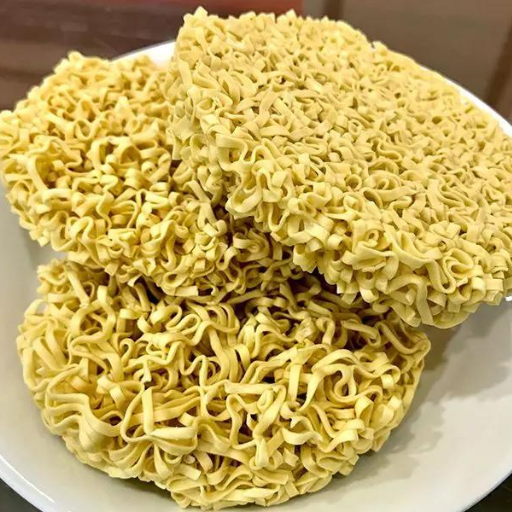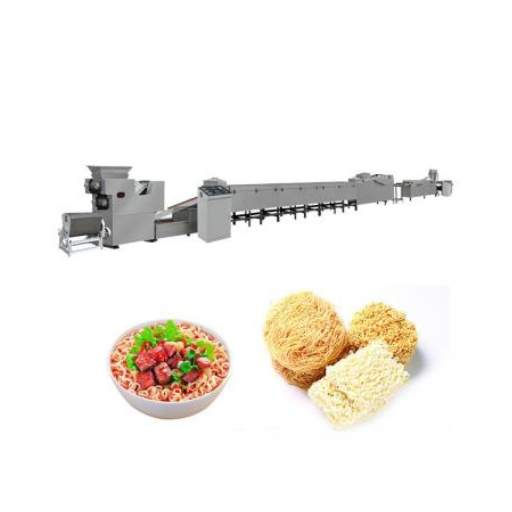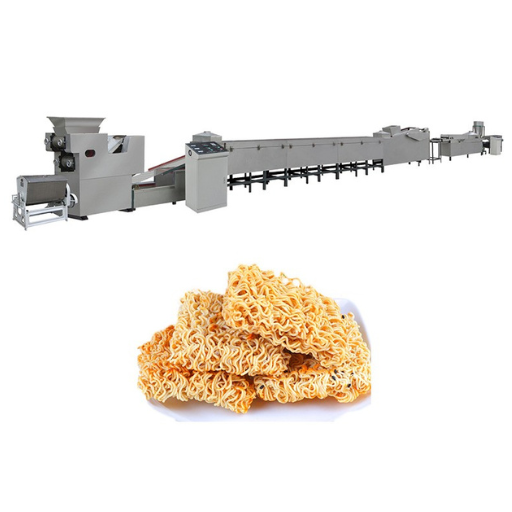Welcome to our in-depth exploration of the fascinating realm of automatic instant noodle production lines. In this article, we’ll delve into the intricacies of how your favorite convenience meal is manufactured with remarkable speed and precision. We’ll cover every aspect of the process, from the preparation of raw ingredients to the packaging of the finished product, shedding light on the technology and innovation that make it all possible. Whether you’re a food industry professional seeking detailed insights or simply a curious consumer, this blog aims to offer a comprehensive overview of the high-speed world behind instant noodles.
What is a Noodle Production Line?
Definition and Components of a Noodle Production Line
A noodle production line is an automated assembly system designed to manufacture instant noodles efficiently and consistently on a massive scale. It includes many machines that the raw materials pass through before properly cooked packed noodles are harvested. Key components of a noodle production line are as follows:
- Dough Mixing Machine: This machine combines wheat flour, water and other additives to form homogeneous dough. Some typical technical parameters are around 15-20 minutes mixing time, 50-200 kg per batch capacity.
- Dough Sheeting Machine: The mixed dough goes into sheeting machine where it is rolled out into thin sheets. Sheet thickness range is usually from 0.5 to 2.0 mm.
- Steaming Machine: Steamed dough sheets gelatinize the starch thus fixing the texture of the noodles. Steam pressure usually ranges between 0.5-1.5 bars; steaming may take about 1-3 minutes.
- Cutting and Forming Machine: After steaming, the dough sheets are cut into various widths and lengths following specifications stated for each product depending on their physical characteristics such as size, taste and appearance among others via precision cutting blades which make sure they have equal sizes.
- Frying or Air-Drying Machine: Fried or air-dried depending on its kind of product, temperature for frying is around 140-160°C with duration of between one to two minutes while air drying takes approximately thirty to sixty minutes at temperatures within sixty to eighty degrees C.
- Cooling Machine: After cooking, cooling occurs quickly until the food reaches room temperature in order to stabilize their structure before packaging them once more in about five up to ten minutes timespan.
- Seasoning and Packaging Machine: If required seasoning then packing individual servings of noodles can be done using this machine alone away from other machines without changing places it was installed using packaging parameters such as sealing temperature at 150-250°C and the rate up to 120 packs per minute.
By combining these components with precise controls and automation, noodle production lines can operate effectively and ensure consistent product quality, which is essential in meeting the huge global demand for instant noodles
The History and Evolution of Noodle Manufacturing
Noodle manufacturing has a rich history that traces back thousands of years, with its origins in China. Ancient Chinese noodles date back to 2000 BC and were made from millet as well as other grains. Techniques and recipes developed over time with wheat based noodles becoming popular during the Han Dynasty (206 BCE – 220 CE).
20th century marked a significant evolution in noodle manufacturing following the invention of instant noodles. First invented by Momofuku Ando in 1958, instant noodles rapidly changed the way people thought about food making it easier to have quick meals on busy days. These revolutionary changes were caused by technological developments in processing methods.
Modern Noodle Manufacturing Processes:
Dough Preparation:
- Flour Mixing: To enable uniform hydration and similar texture.
- Water Ratio: Typically controlled so that there is about 30-35% water content.
Sheeting Machine:
- Adjustable Thickness: Different types of pasta require dough thickness ranging from 0.5 to 2.0 mm.
Steaming Machine:
- Steam Pressure: Ranges between 0.5-1.5 bars.
- Steaming Time: Takes almost one to three minutes or thereabout.
Cutting and Forming Machine:
- Precision Blades: They are employed to ensure consistent dimensions of width as well as length for all strips;
Frying or Air-Drying Machine:
- Frying Temperature: Usually at around140-160°C but this temperature depends on the kind of noodle being cooked because different kinds have different temperatures at which they cook best within a period not exceeding two minutes,
- Air-Drying Time: This air-drying process takes approximately thirty minutes to an hour where temperatures are kept between sixty and eighty degrees Celsius.
Cooling Machine:
- Cooling Time: to stabilize noodle structure it takes around 5-10 minutes to cool the food down until it is at room temperature
Seasoning and Packaging Machine:
- Sealing Temperature: Should be set at 150-250°C.
- Packaging Rate: At most, this can reach up to 120 packs per minute.
Noodle production processes have integral technical parameters which ensure product quality, efficiency and uniformity. Automation and precision control improvements in the course of time has perfected these processes further encouraging mass production to cope with the global demand for noodles.
How Does an Automatic Instant Noodle Production Line Work?
An Instant Noodle Machine’s Role
An instant noodle machine is central to the production line and has several automated processes that help in improving efficiency and consistency. Such include; dough mixing, which creates uniform base through achieving right dough texture as well as hydration keeping them constant at all times. Moreover, dough is rolled and sheeted to exact thicknesses needed for uniform strands of noodles.
Afterwards comes steaming where the strands are cooked under controlled pressure as well as time which determines their final texture. Then the noodles are cut into strips using precise blades ensuring they are of equal length and width. The next process involves either frying or air-drying the noodles depending on whether they are to be consumed instantly or not respectively. Frying is done at high temperatures for a short time to remove moisture content, add flavor while air drying saves fat but keeps the flavors intact.
Lastly, these processed noodles must be cooled so that their structures do not change before adding seasoning materials and packaging them. Besides, this stage is also automated thereby enabling firms involved achieve high rates of even up to 150 packages per minute as opposed to doing it manually such a rate would never be realized by a human being; thus producing about 800 cases daily.
Each step in this sequence is very crucial in maintaining both high quality and large scale manufacturing capacity required to meet world instant noodle demand.
Understanding production process
Instant noodle production process has numerous steps worked out in harmony with one another aimed at ensuring uniformity, quality, and efficiency. Here below is a brief overview based on reliable sources:
- Mixing: It starts with combining flour with water among other ingredients for forming dough that will give rise subsequently into desired forms of spaghetti or macaroni like pasta.
- Sheeting: The dough after that is typically rolled into sheets that have some specific thickness which helps achieve standard formation for noodle strands.
- Cutting and Forming: They involve cutting the dough sheets into fine noodle strands. In this case, precision is needed to ensure that every strand has the same length with others and that they are of equal thickness.
- Steaming: The noodles are then cooked partially by steaming them. This helps set the structure of the noodles and improves their texture.
- Drying: Depending on whether they are oil fried or air dried, different types of noodles require various drying methods. Quick extraction of moisture followed by unique flavor addition in frying form while healthy alternative to this method will be air drying that preserves its taste naturally without any fats.
- Cooling and Packaging: After the noodles have been dried, they need to be cooled for stabilization purposes. Finally, seasoning and packaging take place where these systems package it automatically saving time upholding hygiene as well as extending shelf life.
These steps help to meet global standards of quality and taste in instant noodle production which is a highly demanded food product in today’s world.
Automation in Fried Instant Noodle Production
Efficiency, consistency, and quality are enhanced through automation in production of fried instant noodles. Different types of modern processing plants come with various stages starting from mixing stage where raw material ingredients like flour or starches mixed with water……..The dough texture is maintained uniformly due to automated mixers ensuring correct compositions using specific ratio of each ingredient…. Continuous sheeting as well cutting machines maintains consistent thickness and length noodle strands hence meeting quality control measures for such products.
Steamers that cook at a fast rate make noodles uniformly and then automated fryers, which quickly extract moisture from the noodles, making them acquire their unique taste. Noodles are cooled in controlled environment in cooling tunnels prior to packaging. Lastly, advanced packaging systems ensure that noodles are sealed fast with minimal human intervention to enable hygiene maintenance and shelf life extension. These automations not only enhance production capacity but also make sure every noodle batch meets quality standards rigorously.
What are the Key Features of an Automatic Instant Noodle Production Line?
Ensuring Quality with Food Processing Machinery
To ensure quality in the production of instant noodles, it is important to have innovative food processing machinery which can help in maintaining safety and culinary standards. State-of-the-art mixers and blenders guarantee exact ingredient measurements and even dough texture that is important for making fine noodles. On the other hand, steamer and fryer units are a part of the continuous processing machinery where uniform cooking of noodles can be done with unique flavors while minimizing risks of contamination. The automated visual inspection systems keep out any inferior products from the market to maintain optimal quality in terms of taste and feel. These high-tech machines facilitate real-time monitoring and adjustments aimed at ensuring that the production meets regulatory requirements for flavor, texture, shelf life as well as consumer expectations on this score. Employing cutting-edge technologies in food processing industry helps producers to produce high-quality instant noodles consistently.
The Importance of the Mixing and Dough Sheet Process
In instant noodle production, mixing process as well as dough sheeting plays a crucial role in determining final product’s texture, elastic nature, and overall quality. Initially all ingredients such as flour, water among other additives are mixed uniformly creating consistent dough by being carefully mixed together initially. It is this step that determines how firm or chewy a noodle will be when cooked. The dough is then passed through rollers so as to create sheets – a process involving rolling and stretching – necessary for developing network gluten that gives these items their characteristic bite (elasticity) and resilience during they are being consumed by an individual. To achieve homogeneity in cookery stages as well as finished goods looks; it’s vital to ensure that dough has right thickness/texture before its cuttings commences Ensuring these steps are carried out correctly guarantees attractive looking noodles which meet consumers’ demanding taste & texture benchmarks.
Why Choose a Fully Automatic System?
There are several advantages associated with choosing fully automatic system over semi-automatic one for making instant noodles, which include the following:
- Better Precision and Consistency: Automated systems ensure uniformity throughout different batches by minimizing variation and carrying out process steps accurately.
- Increased Production Efficiency: Fully automatic systems streamline the manufacturing process, reducing downtime and labor requirements resulting in higher production volumes and effective use of resources.
- Improved Hygiene and Safety: This reduces human interference with the product hence reducing contamination chances as well as enhancing strict adherence to hygienic standards.
- Real-Time Monitoring and Adjustments: Such parameters like mixing time, dough thickness or moisture content can be continuously measured by modern sensors and control systems.
Technical Parameters:
- Mixing Time: The duration of mixing is usually controlled within a precision range of 10 – 20 minutes to yield consistent dough texture.
- Dough Thickness: Automatic rolls maintain consistent dough thickness which lies between 1-2 mm for equal cooking as well as texture results.
- Water Absorption Ratio: Water can be precisely added through programmed systems that help keep its weight percentage at around 30%-35% required for proper elasticity and texture of a dough.
- Gluten Development: Advanced technology ensures that the sheeted dough develops gluten network whose quality determines how crispy or chewy it will be during consumption.
Through these technical capabilities, a fully automated system ensures that instant noodles achieve high taste, texture, and appearance benchmarks thus meeting both consumer expectations as well as regulatory demands.
How to Ensure High Production Capacity without Compromising Quality?
How to Maintain High Production Capacity without Compromising Quality?
To keep pace with demand while ensuring quality, it is important to maintain high standards in mass production. The following key strategies have been culled from reputable sources:
- Implement Stringent Quality Control Processes: Regular checks and tests at each stage of production enable early identification and rectification of faults. Utilize systems that can trace all materials and processes in order to address any discrepancies quickly.
- Adopt Cutting-Edge Technology: Acquire state-of-the-art machines that will make quality work possible. For example, automation and robotics can perform repetitive tasks consistently and reduce human mistakes keeping the set levels of quality.
- On-going Employee Training: Qualified staff members are crucial for maintaining quality. Employees should be trained regularly on modern production approaches, adherence to quality assurance principles, as well as observing safety regulations (Cunha & Almeida 1471). This fosters an overall better output.
A combination of strict quality checks, advanced technological applications, and extensive employee training allows firms to achieve both high production capacity and product excellence.
Innovations in Automatic Instant Noodle Production
Efficiency has improved due to innovative developments in automatic instant noodle manufacturing process which do not compromise on the noodles’ quality. Below are some major advancements in technology associated with these innovations:
Automated Mixing and Kneading Systems:
- Parameters: Consistent dough hydration at 35% water content, kneading speed of 60 RPM.
- Justification: This ensures that noodles are uniformly textured and elastic enough, hence making them good instant noodles of top quality.
Precision Cutting And Shaping Machines:
- Parameters: Cutting precision within 0.5 mm tolerance, speed of 200 cuts per minute.
- Justification: This guarantees even lengths and shapes for the noodle strips making uniform cooking possible which satisfies consumers during taking meals.
Advanced Steaming Units:
- Parameters: Steam temperature maintained at 100°C, steaming duration of 2 minutes.
- Justification: For instance, the right amount of gelatinization in starches ensures desirable texture upon rehydration without making them too soft after being cooked by consumers’ (Park et al. 23).
Efficient Drying Systems:
- Parameters: Drying temperature set at 80°C, moisture reduction to 10% within 30 minutes.
- Justification: Fast and uniform drying prevents the growth of microbes and helps maintain their structure as well as shelf-life.
Automated Quality Inspection with Imaging Technology:
- Parameters: Real-time high-resolution imaging at 300 frames per second, defect detection accuracy of 99%.
- Justification: The cameras monitor continuously for defects such as burst bubbles and noodles with cracks thereby ensuring that only quality products are supplied to consumers.
By using these technological innovations, instant noodle manufacturers can greatly enhance production output while still ensuring stringent adherence to quality standards. Every parameter has been meticulously adjusted to optimize productivity in order to achieve efficiency without any compromise on the final product’s superior quality.
Who are the Main Suppliers of Noodle Production Lines?
Leading Providers of Industrial Instant Noodle Production Line
Among the leading providers of industrial instant noodle production line, three names always stand out; Buhler, Shandong Loyal Machinery Co., Ltd and Indofood. The company is known for its comprehensive solutions in food processing machinery which are aimed at enhancing efficiency and quality in the noodle production through cutting edge technology. In addition to this, Loyal brings on board a wealth of experience in the food industry to offer powerful lines of productions that are consistent and having high output. Lastly, Indofood also provides state-of-the art production equipment that are designed to meet the pressures of mass-production within the instant noodles’ market. These companies are market leaders as they provide tailored solutions to instant noodle producers with varying needs.
What should be considered when choosing a supplier?
In selecting an instant noodle production line supplier I consider some key points based on industry standards and input from top suppliers like:
- Technology & Innovation: The provider should come with advanced technological items that assure high proficiency and quality. For example, vendors like Buhler have modernized their machines by incorporating recent advancements in food processing.
- Reliability & Consistency: It is important than anything else that any manufacturing equipment should deliver consistent outputs while maintaining quality standards. This is exemplified by Nestle Professional’s well-known production lines which produce every batch after adhering to strictest specifications.
- Scalability: It is important to be ready for increases in demand for noodles. Consequently, Indofoods’ equipment can handle large volume manufacturing hence it is suitable for growing firms.
- Technical Support & Service: There must be ongoing support and maintenance services. Having a full-time support team is ideal because it can reduce downtime significantly thus keeping your business running smoothly.
- Customizability: Customizable lines that fit unique requirements for production purposes are beneficial. Majority top providers offer custom-made lines for ensuring specific manufacturing needs.
- Cost Efficiency: Though modern technology may be expensive, the cost should not always supersede the value. As such, it is important to look at both the initial capital investment as well as the long run operational costs.
Technical Parameters that Need Attention:
- Production Capacity: The equipment must correspondingly meet your required output.
- Speed: Maximum speed operations are vital for achieving high productivity as mentioned in 300 frames per second for defect detection.
- Defect Detection: It is needed to ensure accuracy in defect detection; hence such aspects like the rate of 99% is appropriate in order to control quality.
These elements have to be considered when choosing a supplier so that a production line can meet its current and future needs effectively and reliably.
Reference sources
-
Shangbaotai: Industrial Instant Noodle Production Line
- Shangbaotai offers a detailed overview of high-speed instant noodle production lines. This source covers key features such as automation, large capacity, energy efficiency, and cost-effectiveness, making it an essential resource for understanding modern instant noodle manufacturing.
- Read More
-
Loyal: Instant Noodle Production Line
- Loyal provides insights into premium instant noodle production lines designed for efficient and high-quality manufacturing. Their detailed descriptions of the machinery and processes involved help validate the feasibility of automated instant noodle production.
-
Kuo Chang: Instant Noodle Production Line (Bag / Bowl Type)
- Kuo Chang explains the step-by-step process involved in the manufacturing of instant noodles, including mixing, compounding, pressing, steaming, cutting, seasoning, frying, and cooling. This comprehensive guide offers a thorough understanding of the entire production line, from start to finish.
- Read More
Frequently Asked Questions (FAQs)
Q: What does fried instant noodle production line mean?
A: Fried instant noodle production line refers to a series of machines used in mass-producing noodles. These systems consist different machine equipments like mixer, cutter and fryer for efficient production of the product.
Q: How Does Automatic Instant Noodle Processing Line Work In The Process Of Making Noodles?
A: Making starts from a mixer where ingredients are mixed together before dough is rolled and cut using a noodle making machine on an automatic instant noodle processing line. The next step is steaming, frying them and finally drying them off before packaging. A detailed flow chart can help visualize these steps.
Q: Can the Production Line Handle Different Types of Noodles such as Ramen and Cup Noodles?
A: Yes, full-cycle noodle production lines like the one Yamato provides have capabilities to handle different types of noodles including ramen noodles and instant cup noodles. Machine parts can be adjusted depending on what kind of noodles are needed.
Q: Why is stainless steel used in making noodle machines?
A: The reason why stainless steel is chosen for making noodle machines includes long-lasting quality of steel, non-corrosiveness, hygiene friendliness which support food cleanliness process while producing foods. This will help maintain the products’ standard.
Q: What Are Advantages Of Using Automatic Fried Instant Noodle Production Line?
A: Use of auto fried instant noodle production line has several benefits which include improved productivity, steady state product quality, minimized labor costs and ability to deal with large scale mass production. Automation gives direct control over each stage involved in making noodles.
Q: How Does The Quality Of Noodle Products Get Assured By The Production Line?
A: With advanced PLC systems designed into the productions lines to monitor each part of the process that makes sure every fresh noodles, rice noodle and instant ramen made are high quality final products consistently offered by this system.



















